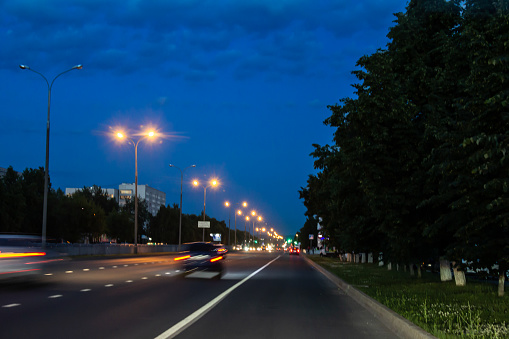Pedestrians, Cyclists More at Risk When Daylight Savings Time Ends

A car accident lawyer explains why
Daylight Savings Time ended on Sunday, Nov. 7, 2021, and now that it is getting darker earlier each day, drivers need to remember to pay special attention to traffic conditions and look out for pedestrians and cyclists.
Driving in dark conditions makes it exceptionally more challenging to notice people walking or riding a bike if you're not being attentive and following the rules of the road. While pedestrians and cyclists can and should increase their visibility by wearing brighter colored clothing and reflective equipment, their safety still largely lies in the hands of motorists.
As such, drivers should remember to eliminate distractions, obey the speed limit, and keep their focus on the road ahead.
Pedestrian & cyclist fatalities spike in 2020
According to the National Highway Traffic Safety Administration, over 7,000 pedestrians and cyclists died in motor vehicle crashes last year. This trend was unexpected, as with fewer drivers on the road due to pandemic restrictions, the largely held belief was those roadway fatalities involving pedestrians and cyclists would go down. Yet last year cyclist fatalities actually increased by 5%, while pedestrian deaths remained flat nationally.
In our area, pedestrian deaths increased slightly. This was due to more traffic on the roads, including foot traffic and cyclists, drivers paying less attention to the dangers around (e.g., cellphones, texting, and there is more construction going on, which changes and obstructs traffic patterns).
According to multiple studies, the most dangerous time of day for pedestrians and cyclists is between 6 p.m. and 9 p.m., with the first hour of darkness posing the most risk.
How to drive in dark conditions
For motorists, the National Safety Council offers the following safety tips when driving at night:
- Ensure your vehicle's headlights are clean and aimed properly.
- Dim your vehicle's dashboard lights.
- Never stare into oncoming headlights.
- Don't use your cellphone or text.
- It's darker, the roads are more crowded and dangerous, so take your time or leave earlier.
- If you wear corrective lenses, consider wearing anti-reflective eyeglasses.
- Make sure that your vehicle's windshield is clean and without chips or cracks.
- Avoid speeding. Visibility is much lower at night, and the faster you're driving, the less time you have to react to a pedestrian or bicyclist using the road.
- Don't drive fatigued. One of the reasons accidents increase in dark conditions is because this is the time of day when the most tired drivers are on the road.
Accidents with pedestrians, cyclists going underreported in DC
Another issue to consider is that pedestrians, cyclists, and scooter riders are greatly underrepresented in Washington, D.C., accident reports. That’s a problem because the statistics are important for ensuring public safety.
Thirty percent of collisions in D.C. involving pedestrians, cyclists, and scooter riders were not documented in crash reports, according to the D.C. Policy Center. The center studied 911 calls over a six-week period, then sought corresponding accident reports.
“Among the pedestrian and cyclist community, I think they’ve known for a long time that the public crash reports weren’t capturing all the crashes,” said Emilia Calma, the center’s deputy director of research and policy. “It’s in MPD (Metropolitan Police Department) policy that they won’t write reports if people don’t want to make statements and there’s a whole bunch of reasons why people might not want to do that.”
The lack of reports is an issue, Calma said, because the information helps identify streets in need of safety measures. Without reports on many accidents, officials are making decisions based on incomplete data.
Calma said the city needs to expand its efforts to collect accident information. Two places to start, she suggested, are the 911 calls and reports from area hospitals.
Safety tips for non-motorists
Again, drivers have a duty to watch out for pedestrians, cyclists, and scooter riders, but there are some things people can do to help protect themselves.
For walkers, the National Highway Traffic Safety Administration says:
- Follow the rules of the road, and obey signs and signals.
- Walk on the sidewalk when one is available. When not available, walk facing traffic and as far from traffic as possible.
- Remain alert and avoid distractions, such as using a smartphone.
- Cross streets at crosswalks or intersections. When not available, use a well-lit area with a good view of traffic.
- Do not assume a driver can see you. Make eye contact.
- Make yourself visible by wearing bright clothing during the day, and reflective materials or carrying a flashlight at night.
The Harvard University School of Public Health, meanwhile, suggests urban cyclists and scooter riders:
- Follow the rules of the road.
- Stay at least three feet from parked cars to avoid colliding with a vehicle door opened by someone who failed to look first (this is known as a "dooring" accident).
- Be aware of blind spots. The larger the vehicle, the larger the blind spot.
- Wear a helmet.
- Utilize lights, reflectors, and bright clothing to increase visibility.
- Obey traffic signals and don’t weave between cars whether they have a red light or not.
Legal help is available when you've been injured
If you were hit by a car and suffered injuries because of a reckless driver, we can help. At the Law Offices of Stuart L. Plotnick, LLC, we aren't afraid to take on the insurance company and fight for every dollar you deserve. We don't back down, and we will aggressively advocate for your best interests, whether that's in settlement negotiations or in court in front of a judge and jury.
To schedule a free consultation with a car accident lawyer serving Maryland, Virginia, and Washington, D.C., contact us today.

